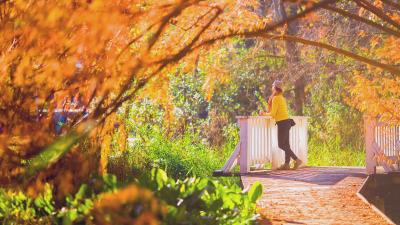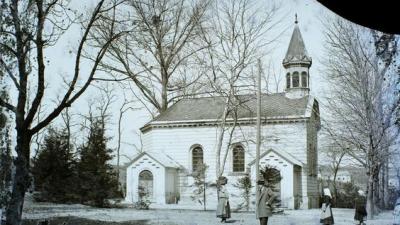Tárolt adatok:
cím: A guide to the churches of Hévíz: secrets, history and more!
lead: They may be old or new, small or large, but churches are always nice to admire in any city. We don’t even have to be a believer to admire their beauty.
tartalom: + 1 The Cross and the Star There is a small eye-catching building in Helikon Street in Hévíz. At its peaks, the symbols -a cross and a star - indicate that we are in a sacred place. There is also a column next to it erected to commemorate the 500th anniversary of the Reformation with the inscription in Hungarian 'Az ige kőszálként megáll', which is a quote from Psalm 46 meaning 'That word above all earthly powers'. Although only a few Protestant residents were registered in Hévíz, a collection was in procession for the construction of a Protestant church by the guests staying here in the 1930s. Bálint Szeghalmy also made a plan in 1941. The money donation was collected for its implementation, but the raging war stopped his dream to become real. Finally in 1993, Hévíz donated a plot of land to build a joint Lutheran-Reformed church. The Lutheran and Reformed congregations decided to implement the old plan of Bálint Szeghalmy in a slightly modernized version, prepared by architect Mihály Zoób. The cross placed on the gable of the church was carved out of white marble at the contractor's own expense. The bell is a donation from the family of Károly Borsos. The foundation stone was placed down on June 16, 1997, and the first service was held on December 6, 1998. In 2003, the church was enriched with the winged altarpiece of the Kossuth and Munkácsy Prize-winning tapestry artist Rózsa Polgár, and in 2004 with the organ designed and built by the organ builder Albert Miklós from Győr. The Heart of Jesus Church, also known as Fradi Church In 1905, in the neighbourhood of the Roman ruins in the Egregy district of Hévíz, a two-storey bell tower was erected in place of the wooden belfry that had stood there for more than 100 years. In 1937, from local donations, the bell tower was expanded with another level and a tin roof. It was built in a Neo-Romanesque style with twin windows. Two bells were placed in the tower, a smaller one in honor of Mary Magdalene, which was cast in 1905, and a larger one in memory of the 16 heroic soldiers of Egregy who fell in World War I. The latter was made in 1937. In memory of the heroes, 16 linden trees were planted next to the tower, with a head tree at their base. The bell tower was then renovated in 1990 with the voluntary donation of the people of Egregy, and on April 22, 1995 it was consecrated as the Church of the Heart of Jesus. And why is it called Fradi Church by the locals? Because the church, which was built largely from donations, received unexpected help, as the Ferencváros Gymnastics Club (a famous Hungarian football team from Budapest, nicknamed as Fradi) was also among the donors as well. Not only did the supporters make a financial contribution, but the team and club leadership were present at the consecration of the church. They even donated Fradi Relics to the church (most recently in 2017), which visitors of the church could see in a display case. In light of this, it is not surprising that the church, originally designed in blue and white, was eventually painted green and white which are the official colours of the football team. Next to the church, a military memorial park was established in 2000 to commemorate the soldiers, civilians and Jewish victims of Egregy and Hévízszentandrás who fell in the First and Second World Wars. In doing so, 70 named headstones were erected. However, only 6 remained of the former 16 linden trees planted. The Catholic Church on the shores of Lake Hévíz The western shore of Lake Hévíz (today's Schulhof Promenade and the area of the hospital buildings) used to belong partly to the village of Szentandrás and partly to the bishopric of Veszprém. These areas became the property of the Festetics family in 1857 and 1868 through land swaps. Soon after the expansion of the bath land near the lake and landscaping could begin. The row of the completed (except for one building) 7 bath buildings was completed by a chapel. Its construction began in the 1870s and was consecrated in 1877. We only have a few old engravings and postcards from the chapel, and we also found only a few photos of the inside. The chapel was finally demolished in 1964, when the most modern balneotherapy center in the country was built in its place in the most modern architectural style of the time. It is essentially the hospital’s indoor thermal bath, the Winter Bath, today’s Indoor Bath and Therapy Center, which was handed over in 1968. The altar of the old Church is going to be exhibited soon on the renovated Shulhof Promenade. The Holy Spirit Church The most modern and well-known church can be seen from the beginning of the main street leading to the city, as its blue peaks rise high. The church opposite the town hall, which can accommodate up to 1,000 people, was built according to the plans of János Bocskai and was consecrated on September 9, 1999 by retired Archbishop József Szendi. Breaking into the seven (5 middle and 2 side) towers, the tower guides its visitors to the city from afar. The seven towers symbolize the seven gifts of the Holy Spirit, while the pigeon motif symbolizing the Holy Spirit appears in several places on the building (even the shape of the church looks like a dove opening its wings if we look at the church from the air). On the one hand, in the floor plan of the church, in the design of the floor in front of the entrance, in the motifs of the interior wood and in the painting of the glass window above the main altar. The interior of the church combines modern architecture and tradition, which is mainly emphasized by the beautiful wood paneling. Due to its good acoustics, it often hosts organ and acoustic concerts. The colorful windows, reminiscent of Gothic style, praise the work of Simon Endre, an artist from Hévíz. The torso on the wall of the sanctuary is a 200-year-old art treasure that was donated to the church. The bronze statue of Christ on the left side of the altar and the statue of Our Lady of Hungary wearing the crown on the right side are also the work of László Marton. The walls are decorated with fire enamel pictures. No bells were placed in the tallest tower for static reasons, but 2-2 bells were placed in the towers to the left and right. Two bells were brought here from 2 old churches in Hévíz, while the other two were donated by families in Hévíz. By the way, the church is mostly mentioned only by the locals and guests as "Blue Church". The Synagogue, only a memory If we walk towards the Protective Forest of the Lake, next to the entrance to the Deák Square of the Lake Bath, a monument appears at the foot of the trees in the park. The synagogue of Hévíz used to stand here. The lines of the monument evoke the facade of the building of the former house of prayer, with names on it that were once taken from here to death. Among others, dr. Chief physician Vilmos Schulhof. There were not many Jews living in Hévíz, it is estimated that there could be no more than 2-3% of the population, yet this community was strong enough to build a synagogue in 1933. It is a strange game of fate that the building survived both the Holocaust and the war fortunately, but by 1959 the religious life in Hévíz had ceased. As a result, the house of prayer was not used, its condition greatly deteriorated, so it was demolished in 1977. The monument, erected in 2000, in its simplicity commemorates the former synagogue on the one hand and the former local Jewry on the other, and the pebbles placed on it indicate that faith has survived. Árpádian church in Egregy, the Church of St. Magdalene The exact time of construction of the church is unknown, it was probably built around mid-13th century. It is first mentioned in written records in 1341. The building was badly damaged in the 16-17th century, and was later renovated in the Baroque era in 1731. Fortunately, only the most necessary parts were repaired, so the medieval form of the church has been preserved. During this renovation, the interior and exterior decorative paintings, the elevation of the ship, and the vaults were also replaced. The first patron saint of the church was St. Catherine of Alexandria. After the rebuilding, it was rededicated and its new patron saint became St. Magdalene. Since then, the church has been restored several more times: in 1860, 1912, 1964-65, 1990 and 1991, and most recently in 2015. On the south side of the church, we can find an open baroque door. The vault of the tower was renovated in the 18th century and is joined by a rectangular nave with a sanctuary. Inside the church, the only decorative element, is the row of booths on the north wall. The wall painting of the church is not of medieval origin, but it shows respect for the folk elements. Inside the building, there is a fragment of a Romanesque baptismal font and a medieval consecrated cross. Its tower has three floors and a rich design, with two and three twin windows opening on the levels. The tower is closed by a bucket helmet, which is stiffened by eight wooden beams. In terms of its foundations, it mainly preserved the forms of wooden architecture. Painted decorations and incised shapes have survived on the exterior surfaces. The church may have remained in this form because it lost its significance during the centuries. The former settlement was largely depopulated, the inhabitants moved a little further down the valley, so this church only served as a cemetery chapel. Therefore, it was not important to expand or transform it significantly. An Orthodox church built in honor of the “Life-giving Source” icon of the Holy Mother of God The foundation stone of the Orthodox church was placed down on 27 December, 2019 in Hévíz. The church which is still under construction will be accessible from Ady Street. Construction of the church began in the spring of 2020. As metropolitan Mark put it: their choice fell on Hévíz because here the healing of body and soul is possible at the same time, and because Hévíz boasts that Emperor Theodosius owed his life to the water of Hévíz and became one of the most influential in the Roman Empire according to an old legend. The church is based on the plans of the Ybl-awarded architect László Vánca. The 15x15 meter church is traditionally made of brick, with masterfully smoothed corners on its sending walls showing the asymmetrical relief niches, which are masterful combinations of modern and ancient motifs. The Orthodox tower helmet will be adorned with an eight-pointed gold-clad cross. Although the church is not yet finished within the walls under construction, services are already being held. Explore our beautiful city and see the many faces of the churches in town!
title: A guide to the churches of Hévíz: secrets, history and more!
description: They may be old or new, small or large, but churches are always nice to admire in any city. We don’t even have to be a believer to admire their beauty.
címkék:
fókusz kulcsszó:
szinoníma címkék:

